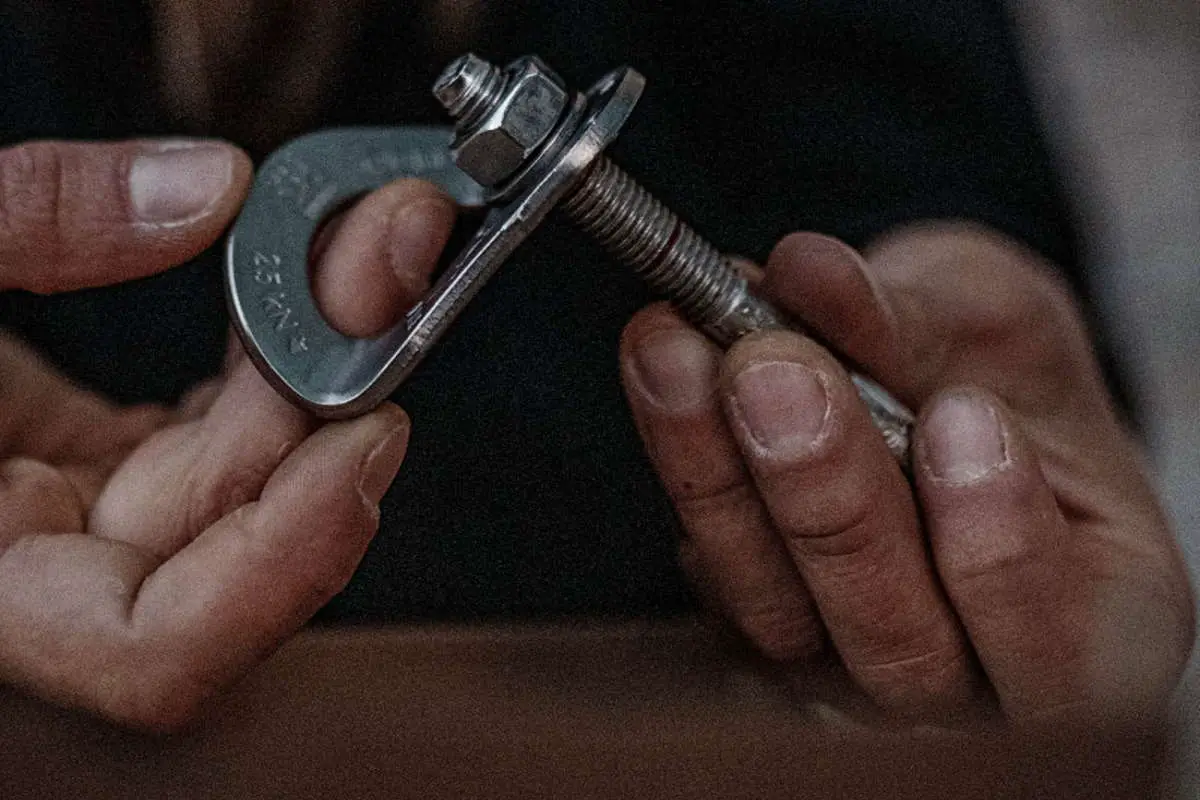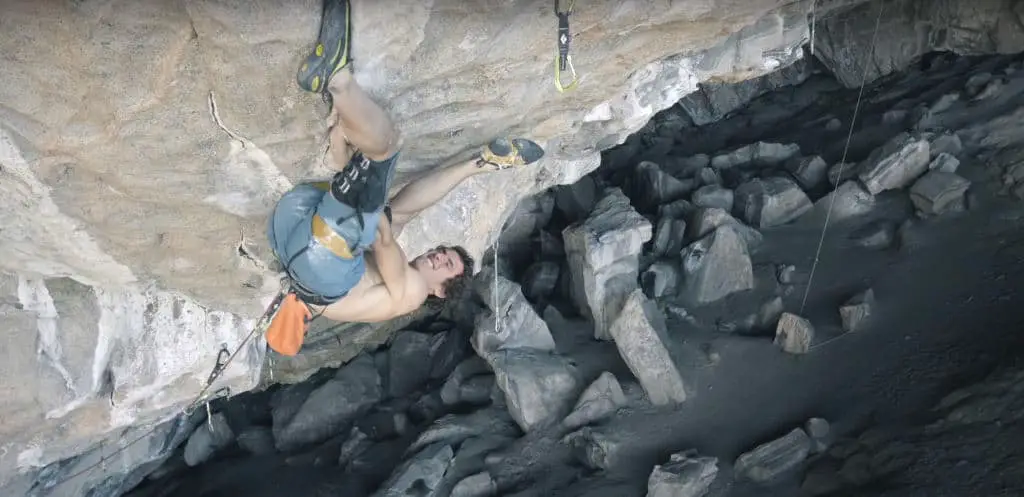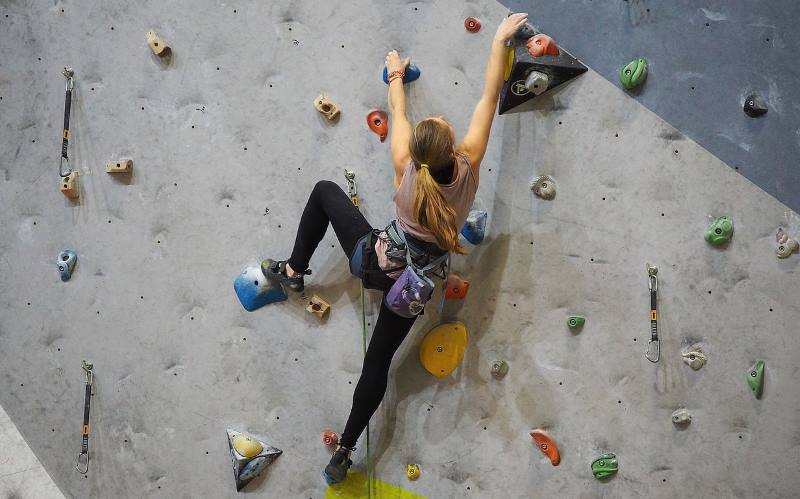In the wonderful world of weird climbing jargon redpoint is up there as one of the least obvious. Originating as a nod to a German coffee jug at the dawn of sport climbing and now the basis of the pursuit- let’s answer the common question: what is a redpoint in climbing?
You’ll probably hear the term redpoint quite a lot if you’ve started climbing recently. It’s essentially the main way climbers will measure if they’ve climbed a route ‘properly’. You might hear someone saying they are redpointing or have redpointed a certain climb.
Redpointing is mainly used in sport climbing though also sometimes in trad or traditional climbing. Sport climbing is fairly safe as you attach to the wall using fixed protection which consists of bolts drilled or glued into the wall. As you you climb you attach a quickdraw – two carabiners attached by a sewn sling – into the bolt, then clip your rope into the other side.
What Is A Redpoint?
Redpointing means climbing a route in one go from the ground to the finish without resting on the rope or falling. All of the quickdraws or protection can be placed ahead of time and it’s fine to practice the route as long as you’d like in any way you’d like. As long as the final attempt is done cleanly in one go – clipping in as you go on lead – then it’s a redpoint.
Redpointing is all about climbing the route yourself without pulling on anything artificial. The rope, quickdraws and bolts are just there to protect you if you fall. Doing a route this way is sometimes called doing it clean.

Top-roping a route without falling or resting isn’t redpointing, it must be on lead. If you climb the route first time without a fall it could count as a flash or an onsight.
More Climbing Jargon Explained
– What Is Climbing Beta?
– What Does Climbing Onsight Mean?
– What Is A Runout In Climbing?
Onsight means you’ve just walked up and climbed it without scouting out the holds or getting any advice/beta. To Flash a route means you might get some advice beforehand, on the route, maybe you rappeled in and checked the holds, or watched a video about the route. Whether it’s OK for someone to have placed the quickdraws already for either of these is another conversation.
Why Is Redpointing The Standard?
With the changing ethics of climbing in the 70’s and 80’s came mixed ideas of what the new “standards” should be. Whereas before the way that a route was protected and the tactics used were very important, now it was all about the difficulty. Climbing a route without falling, just you against the rock, was now the ideal.
If hanging, falling, and practicing on the route were now fine then why insist that quickdraws were always placed on lead? It can definitely be argued that placing protection is part of the climb itself but falling just because of an awkward bit of gear happens all the time.
Over the years different standards were accepted and climbers would report the exact way a route was done. Nowadays we just expect that the hardest routes were redpointed instead of placing gear on lead. It’s also interesting to see when hard routes get onsighted or flashed because of the determination needed to give it all on that first go.
Does It Matter If I Redpoint A Route?
Do whatever you want. For most people taking a rest or one fall on a route isn’t enough reason to pull the rope and try it all again. If you want to push yourself and measure your progress then knowing what you can redpoint or what you can flash/onsight are good ways of doing so.
What Is A Pinkpoint?

Redpointing actually used to mean climbing without falling, placing all of the gear on lead. Pinkpointing was when the gear was already placed and you just clipped in as you climbed.
Essentially that means when people say they climbed something as a redpoint with the modern standards it’s technically a pinkpoint. However with the times this has gone out of the window. People generally accept redpoint as meaning just clipping in on lead, quickdraws placed already, without falling.
Where Did The Term Redpoint Come From?
Luckily there’s an entire 51 minute documentary to explain it! Or in one sentence: It comes from the German ‘Rotpunkt‘, a red dot painted on routes that could now be done “free” without aid. It started in the Frankenjura which is a historic rock climbing area in southern Germany.
Back in the day climbing was done “by any means” with the aid of pegs, hammers, and anything else you can think of. Aid climbing is still practiced but generally only on big walls that take weeks to climb. As climbers become stronger and technique became more important – this all changed.
In the Frankenjura area, climbs that had only previously done with aid started to have little red circles painted underneath. The rotkreis or red circle was an unfilled red circle that let people know that it had been free climbed without any aid. Once the route had been done from the ground up without a fall then the climber would fill in the circle, which would then be the rotpunkt, aka the redpoint.
Kurt Albert was the person to start doing this and others adopted it. Essentially it was a way of saying something like – stop pulling on gear and climb it clean. The term got picked up by visiting climbers and spread, though the dots aren’t painted on new routes nowadays. Why redpoint? The guys doing the redpoints had a coffee pot with a red dot on it.

Wolfgang Güllich once said – “A man doesn’t go to drink coffee after climbing, coffee is an integral part of the climbing”.
More Useless Incredibly Helpful Climbing Trivia
– Hardest Sport Climbs In The World
– Best Climbing Documentaries & Films
– Famous Free Solo Climbers
– What Is A Sandbag In Climbing
– What Is Sport Climbing?
What Are The Redpoint Rules?
There aren’t any written rules. Redpointing at indoor climbing gyms is technically always a pinkpoint because all the quickdraws are pre-placed and not removable. Outside you might pre-clip the first one or two quickdraws with a stickclip. Normally done for safety and generally acceptable up to a limit.
The only real accepted rules are that you climbed the route from the start to the finish without resting on the rope and you only used the rock. Some will argue about whether you have the clip the chains to finish, and sometimes you see climbers getting to the last accepted hold and then grabbing the chains. It all depends on the route.
Can You Rest On A Redpoint?
Many routes including some of the hardest climbs in the world have rest points. If a good jug or a full knee bar is possible on a route it’s normally fine to use it – even for a few minutes. There’s no acceptable rest timer either, so some pros have taken 5 minutes or more just to shake out and recover half way. As long as you’re resting on the rock and not the rope it’s deemed OK(ish).
Climbing ethics have changed a lot. Bolts were the cause of actual fights and were sometimes (still are….) chopped and removed. Falling used to mean lowering to the ground and trying again. Rappelling in to practice was blasphemous. At the same time chipping and creating holds was at one time very common.




Comments are closed.